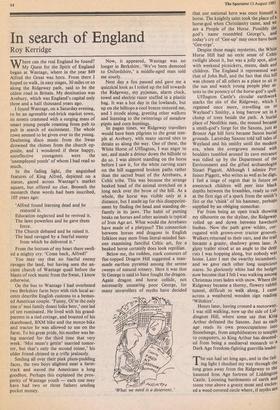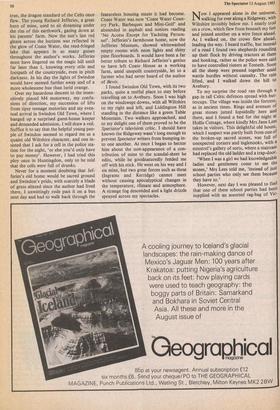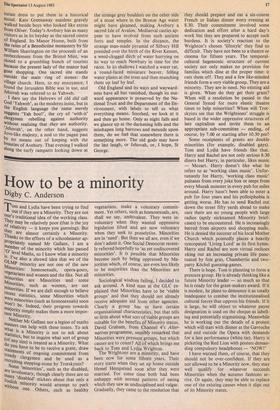In search of England
Roy Kerridge
Where can the real England be found? My Quest for the Spirit of England began at Wantage, where in the year 849 Alfred the Great was born. From there I hoped to walk, in easy stages, 30 miles or so along the Ridgeway path, said to be the oldest road in Britain. My destination was Avebury, which was England's capital only three and a half thousand years ago.
I found Wantage, on a Saturday evening, to be an agreeable red-brick market town, its streets crammed with a surging mass of smart young people roaming from pub to pub in search of excitement. The whole town seemed to be given over to the young. Deafening disco music from the Swan drowned the chimes from the church op- posite, and I wondered if these happy, unreflective youngsters were the 'unemployed youth' of whom I had read so much.
In the fading light, the anguished features of King Alfred, depicted on a statue, gazed across Wantage's market square, but offered no clue. Beneath the monarch these words had been inscribed, 105 years ago: 'Alfred found learning dead and he restored it.
Education neglected and he revived it. The laws powerless and he gave them force.
The Church debased and he raised it. The land ravaged by a fearful enemy from which he delivered it.'
From the bottom of my heart there swell- ed a mighty cry: 'Come back, Alfred!'
You may say that no fearful enemy ravages the land, but having seen the an- cient church of Wantage quail before the blasts of rock music from the Swan, I know otherwise.
On the bus to Wantage I had overheard two Berkshire farm boys with rich local ac- cents describe English customs to a bemus- ed American couple. 'Funny, Oi'm the only one o' moi family doant loike beer,' one lad of ten ruminated. He lived with his grand- parents in a tied cottage, and boasted of his skateboard, BXM bike and the motor-bike and tractor he was allowed to use on the farm. To his great pride, his mother was be- ing married for the third time that very week. `Moi mum's gettin' married tomor- rer, but that's only the second toime,' his older friend chimed in a trifle jealously.
Smiling all over their pink plum-pudding faces, the two boys alighted near a farm- track and waved the Americans a long goodbye. Perhaps this explained the pros- perity of Wantage youth — each one may have had two or three fathers sending pocket money. Now, it appeared, Wantage was no longer in Berkshire. 'We've been demoted to Oxfordshire,' a middle-aged man told me sourly.
Next day a fox paused and gave me a quizzical look as I toiled up the hill towards the Ridgeway, my pyjamas, alarm clock, towel and electric razor stuffed in a plastic bag. It was a hot day in the lowlands; but up on the hilltops a cool breeze restored me, and I strode along, greeting other walkers and listening to the twitterings of meadow pipits and corn buntings.
In pagan times, we Ridgeway travellers would have been pilgrims to the great tem- ple at Avebury, with many sacred sites to detain us along the way. One of these, the White Horse of Uffington, I was eager to see, and made a detour down the hillside to do so. I was almost standing on the horse before I saw it, for the white curving scars on the hill suggested broken paths rather than the sacred beast of the Atrebates, a Celtic tribe. This was because the strange beaked head of the animal stretched on a long neck over the brow of the hill. As a whole, the horse was visible only at a distance, but I made up for this disappoint- ment by finding the head and standing de- fiantly in its jaws. The habit of putting beaks on horses and other animals is typical of Iron Age art. What would the Atrebates have made of a platypus? The connection between horses and dragons in English folklore may stem from literal-minded Sax- ons examining fanciful Celtic art, for a beaked horse certainly does look reptilian.
Below me, the sudden, stark contours of flat-topped Dragon Hill suggested a man- made earthen pyramid among the serene sweeps of natural scenery. Here it was that St George is said to have fought the dragon. Again dragon and horse collide, not necessarily unseating poor George, for many unravellers of myths have decided 'What we need is a deterrent.' that our national hero was once himself a horse. The knightly saint took the place of a horse-god when Christianity came, and we are a People of the Horse. Possibly the god's name resembled George's, and today's cry of `Gee-up' may once have been 'Gee-orge'.
Despite these magic mysteries, the White Horse Hill had no eerie sense of Celtic twilight about it, but was a jolly spot, alive with weekend picnickers, mums, dads and children. The England it represented was that of John Bull, and the fact that this hill was chosen of all others as a place to sit in the sun and watch young people play at- tests to the potency of the horse-god's spell.
Uffington Castle's circular earthwork marks the site of the Ridgeway, which I regained once more, travelling on to Wayland's Smithy, a long barrow set in a clump of trees beside the path. A burial place of Neolithic men, the mound became a smith-god's forge for the Saxons, just as Bronze Age hill forts became Saxon burial grounds. Latterday Saxons told tall tales of Wayland and his smithy until the modern era, when the overgrown mound with boulders tumbled around its cave entrance was tidied up by the Department of the Environment and the gifted archaeologist Stuart Piggott. Although I admire Pro- fessor Piggott, who writes as well as he digs, I feel a tinge of regret that in future no awestruck children will peer into black depths between the brambles, ready to run at the first sign of a spark from the smith's fire or the 'chink' of his hammer, perhaps supplied by an obliging stonechat.
Far from being an open track showing my silhouette on the skyline, the Ridgeway rolled up and down between hawthorn bushes. Now the path grew wilder, cor- rugated with grown-over tractor grooves. Walkers returned to their cars, and the trail became a grassy, shadowy green lane. A gipsy trailer stood at an angle to the deep ruts I was hopping along, but nobody was home. Later I met the swarthy incumbent, and we gave each other long suspicious stares. So gloriously white had the hedges now become that I felt I was walking among Christmas trees laden with snow. Where the Ridgeway became a thorny, flowery rabbit tunnel, difficult to walk along, I came across a weathered wooden sign reading `Wiltshire'.
Hours later, having crossed a motorway' I was still walking, now up the side of Lid- dington Hill, where some say that King Arthur defeated the Saxons. Just as each age reads its own preoccupations into Stonehenge, from amphitheatres to temples to computers, so King Arthur has descend- ed from being a mediaeval monarch to a Dark Age freedom-fighting guerrilla leader.
The sun had set long ago, and in the fail- ing light I shushed my way through the long grass away from the Ridgeway to the haunted Iron Age fortress of Liddington Castle. Looming battlements of earth and stone rose above a grassy moat and enclos- ed a weed-covered circle where, if myths are
true, the dragon standard of the Celts once flew. The young Richard Jefferies, a great hero of mine, used to sit dreaming under the rim of this earthwork, gazing down at his parents' farm. Now the sun's last red gleam across the horizon was reflected in the glow of Coate Water, the reed-fringed lake that appears in so many guises throughout the author's works. Jefferies must have lingered on the magic hill until far later than I, knowing every stile and footpath of the countryside, even in pitch darkness. In his day the lights of Swindon would have seemed further away and of a more wholesome hue than lurid orange.
Over my hazardous descent to the insen- sitively placed M4 motorway, my confu- sions of direction, my succession of lifts from tipsy teenage motorists and my even- tual arrival in Swindon Old Town, where I banged up a surprised guest-house keeper and demanded admission, I will draw a veil. Suffice it to say that the helpful young peo- ple of Swindon seemed to regard me as a quaint old Wiltshire character, and one in- sisted that I ask for a cell in the police sta- tion for the night, 'or else you'd only have to pay money'. However, I had tried this ploy once in Huntingdon, only to be told that the cells were full of drunks.
Never for a moment doubting that Jef- feries's old home would be sacred ground and Swindon's pride, with scarcely a blade of grass altered since the author had lived there, I unwittingly rode past it on a bus next day and had to walk back through the
featureless housing estate it had become. Coate Water was now 'Coate Water Coun- try Park, Barbeques and Mini-Golf' and abounded in asphalt and notices reading 'No Access Except for Yachting Person- nel'. Jefferies's farmhouse home, now the Jefferies Museum, showed whitewashed empty rooms with neon lights and shiny pine floorboards. It would have been a far better tribute to Richard Jefferies's genius to have left Coate House as a working farm, amid unspoilt countryside, let to a farmer who had never heard of the author of Bevis.
I found Swindon Old Town, with its two parks, quite a restful place to stay before travelling on to Avebury. Soon I was high on the windswept downs, with all Wiltshire to my right and left, and Liddington Hill standing in the distance like a green Table Mountain. Two walkers approached, and to my delight one of them proved to be the Spectator's television critic. I should have known the Ridgeway wasn't long enough to prevent Spectator writers from bumping in- to one another. At once I began to hector him about the non-appearance of a con- tribution of mine to the scandal-sheet he edits, while he goodnaturedly fertded me off with his stick. He went on his way and 1 on mine, but two great forces such as these (Ingrains and Kerridge) cannot meet without causing apocalyptical changes in the temperature, climate and atmosphere. A strange fog descended and a light drizzle sprayed across my spectacles. Now 1 appeared alone in the universe, walking for ever along a Ridgeway, with Wiltshire invisibly below me. 1 nearly trod on a crow, which flew from beneath my feet and joined another on a wire fence ahead. As I walked on, the crows flew ahead, leading the way. I heard traffic, but instead of a road I found two shepherds rounding up their flock by driving tractors at than and honking, rather as the police were said to have controlled rioters at Toxteth. Soon all the sheep were pressed together amid wattle hurdles without casualty. The rain lifted, and I walked down the hill to Avebury.
To my surprise the road ran through a gap in tall Celtic defences spread with but- tercups. The village was inside the fortress, as in ancient times. Rings and avenues of great stones jutted lopsidedly here and there, and I found a bed for the night at Hollis Cottage, where kindly Mrs. Jane Lees takes in visitors. This delightful old house, which 1 suspect was partly built from one of the broken-up sacred stones, was full of unexpected corners and inglenooks, with a minstrel's gallery of sorts, where a staircase had replaced the old ladder and a trap-door.
'When I was a girl we had knowledgeable ladies and gentlemen come to see the stones,' Mrs Lees told me, 'instead of just school parties who only see them because they have to.' However, next day 1 was pleased to find that one of these school parties had been supplied with an assorted rag-bag of Vic- ., torian dress to put them in a historical mood. Kate Greenaway maidens gravely walked beside boys who looked like extras from Oliver. Today's Avebury has as many visitors as in its heyday as the sacred centre of England. Its Manor House, built from the ruins of a Benedictine monastery by Sir William Sharrington on the proceeds of an embezzlement from the Bristol Mint, was closed to a grumbling bunch of tourists because the present lady of the manor had gone shopping. One sacred site stands outside the main ring of stones: the village church. Here, to my annoyance, I found the Jerusalem Bible was in use, and Jehovah was referred to as Yahweh.
I dare say the Hebrews of old did call God 'Yahweh', as the moderns insist, but in the English language the name merely suggests 'Yah bool', the cry of `with-it' clergymen rebelling against authority without realising that they are authority. `Jehovah', on the other hand, suggests Jove-like majesty, a nod to the pagan past by no means out of keeping with the beauties of Avebury. That evening I walked along the turfy ramparts looking down at the strange grey boulders on the other side of a moat where in the Bronze Age water might have gleamed, making Avebury a sacred Isle of Avalon. Mediaeval castles ap- pear to have evolved from such ancient forts and temples. In the distance, the strange man-made pyramid of Silbury Hill presided over the birth of the River Kennet, a weed-clogged ditch of water hurrying on its way to reach Newbury in time for the races. In its shallows I watched a water rat, a round-faced miniature beaver, felling water plants at the stem and then munching them up leaf by leaf.
Old England and its ways and wayward- ness have all but vanished, though its out- ward appearance is preserved by the Na- tional Trust and the Department of the En- vironment, with labels to tell us what everything means. Soothed, we look at it and then go home. Only as night falls and we glance up at the darkening hills and the misshapen long barrows and mounds upon them, do we feel that somewhere there is something more. The old gods may have the last laugh, or Jehovah, or, I hope, St George.








































 Previous page
Previous page